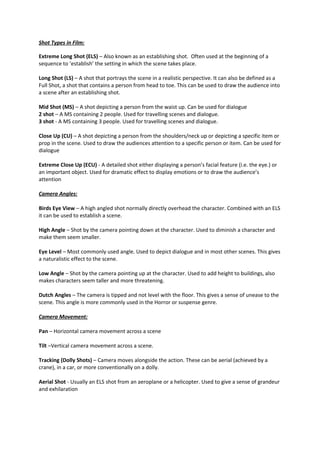
Camera shots, angels + movement handout
- 1. Shot Types in Film: Extreme Long Shot (ELS) – Also known as an establishing shot. Often used at the beginning of a sequence to ‘establish’ the setting in which the scene takes place. Long Shot (LS) – A shot that portrays the scene in a realistic perspective. It can also be defined as a Full Shot, a shot that contains a person from head to toe. This can be used to draw the audience into a scene after an establishing shot. Mid Shot (MS) – A shot depicting a person from the waist up. Can be used for dialogue 2 shot – A MS containing 2 people. Used for travelling scenes and dialogue. 3 shot - A MS containing 3 people. Used for travelling scenes and dialogue. Close Up (CU) – A shot depicting a person from the shoulders/neck up or depicting a specific item or prop in the scene. Used to draw the audiences attention to a specific person or item. Can be used for dialogue Extreme Close Up (ECU) - A detailed shot either displaying a person’s facial feature (i.e. the eye.) or an important object. Used for dramatic effect to display emotions or to draw the audience’s attention Camera Angles: Birds Eye View – A high angled shot normally directly overhead the character. Combined with an ELS it can be used to establish a scene. High Angle – Shot by the camera pointing down at the character. Used to diminish a character and make them seem smaller. Eye Level – Most commonly used angle. Used to depict dialogue and in most other scenes. This gives a naturalistic effect to the scene. Low Angle – Shot by the camera pointing up at the character. Used to add height to buildings, also makes characters seem taller and more threatening. Dutch Angles – The camera is tipped and not level with the floor. This gives a sense of unease to the scene. This angle is more commonly used in the Horror or suspense genre. Camera Movement: Pan – Horizontal camera movement across a scene Tilt –Vertical camera movement across a scene. Tracking (Dolly Shots) – Camera moves alongside the action. These can be aerial (achieved by a crane), in a car, or more conventionally on a dolly. Aerial Shot - Usually an ELS shot from an aeroplane or a helicopter. Used to give a sense of grandeur and exhilaration
- 2. Zoom – Used to focus on an object within a scene without editing. Can be achieved by a zoom lens or by physically moving the camera closer to the object